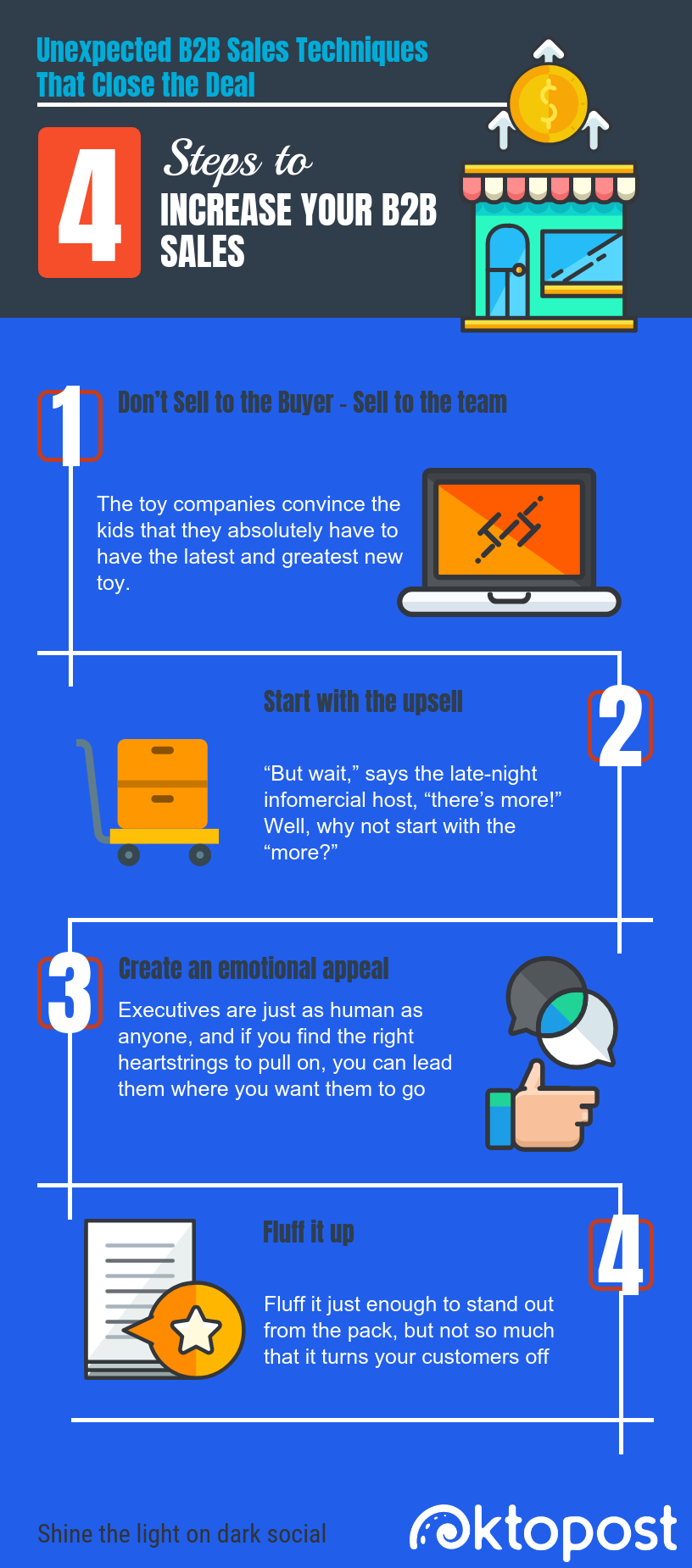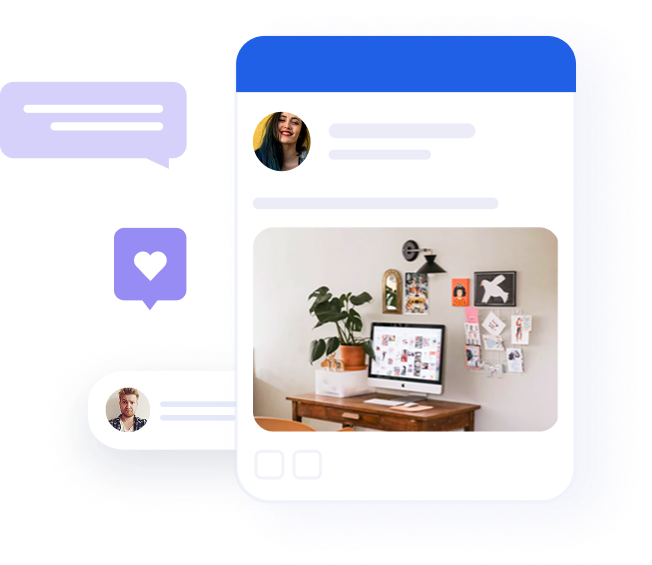
4 unexpected B2B sales techniques that close the deal
Table of contents
When you’re in sales, you hear a lot of advice from people about how to be better at sales. It often comes from other salespeople talking about what has and hasn’t worked for them. Your friends who’ve been on the receiving end of a sales pitch — or that have seen “Glengarry Glen Ross” a few too many times — may share their ideas with you. No matter who they are or what their level of experience is, everyone wants to tell you how to close your next deal.
Of course, when you’re trying to close a huge and critical business-to-business sale, it’s not really helpful to reflect on anecdotes and movie quotes. At the same time, falling back on the safest, most timeworn sales techniques isn’t always the best way to convince the stakeholders at the other end of the table to commit to a major purchase.
Sometimes, you have to put conventional wisdom aside and try an approach that’s less obvious. This is especially true in B2B sales, where the cycle is longer, and there are more people you need to convince. In this situation, the stakes for both parties are much higher than in a one-to-one transaction.
If you’re in a holding pattern with a potential B2B buyer that should be a slam dunk for your product and sales methods, it’s time to switch up your strategy, think outside the box, and give your brain a little push. With that in mind, here are four unexpected sales techniques that can help you get some traction in a stalled sales process.
The 4 unexpected B2B sales techniques that close the deal

1. Don’t sell to the buyer – sell to their team
Who buys toys for children? Their parents. Who do toy manufacturers advertise to? Children.
The toy companies convince the kids that they absolutely have to have the latest and greatest new toy. The kids get to work converting the actual buyers — their parents — to make the purchase. It all works out for the best, since the child is the one who’s going to use the toy anyway. Nothing the advertiser can say to the parents will carry nearly as much weight as the kids themselves telling their parents how much they want it.
In a B2B context, this would mean winning over the team that’s going to actually use your product — so they can convince the buyers in their organization that your product is the best possible option. This ties into the well-established B2B selling concept of relational sales, or consultative selling, where the objective is to build a relationship with the customer. Then you learn through ongoing consultation and discuss what their needs are, and how you can address them.
“Lunch and Learn” events and other voluntary, low-stakes approaches can be an effective way to reach programmers, designers, and other teams within an organization in order to start building an advocacy base for your product. By networking and establishing a rapport with the end-users, you may be able to get through to the buyers more effectively than you could with a direct approach.
2. Start with the upsell
“But wait,” says the late-night infomercial host, “there’s more!”
Well, why not start with the “more?” If the buyer journey isn’t going in the direction you want, try reversing it. This methodology shares some DNA with the old sales technique of starting with an eyebrow-raising high initial offer, then letting the buyer haggle you down, but with some actual substance behind it.
In the typical buyer journey, you identify the problem they need addressed and show them how your product will resolve all their troubles. Once they’ve committed to purchasing the base product, you try to upsell them on the added features, extra packages, extended warranty, etc.
By saving all of your bonus features and optional add-ons for the very end of the sales cycle, you might be depriving the decision-makers you’re trying to reach of the selling points that will be the most attractive to them. If they aren’t interested in the extras and only want the base product, you can help them feel like they’re getting a better deal by letting them negotiate the product price down and decline unwanted features.
After all, everyone likes to feel like a shrewd negotiator now and then. Starting high and working it back can add just the right amount of drama to the sales process. Sometimes, that’s exactly what the buyers need to feel engaged and committed.
3. Create an emotional appeal
Decision-making executives often like to feel like they approach the buying process with cold Vulcan logic. The need X; they’re willing to pay Y; if the seller’s solution can do X and doesn’t cost more than Y, they’ll buy it — because that is the logical and rational thing to do.
We all know this isn’t how it ends up working out. Executives are just as human as anyone, and if you find the right heartstrings to pull on, you can lead them where you want them to go. A sales process that is overly reliant on sterile facts, data, and statistics will tick off all the boxes on the buyers’ checklist. But if that isn’t enough to close the deal, there’s a good chance that the magic ingredient you’re missing is appealing to their emotions.
Of course, emotional appeals in a B2B context are going to mean something different from, say, heartwarming phone company commercials about separated families reconnecting over the holidays with the help of a new wireless bundle. Instead, you want to tap into the emotions around their business, the goals they hope to achieve with it, and the challenges that your product can help them overcome.
Easier said than done? Absolutely — but there’s always a way to reach buyers on an emotional level. You just have to put the work in to understand what’s driving their decision-making process.
4. Fluff it up
Salespeople who come from a background in tech often romanticize the idea of letting the product speak for itself, winning over buyers on the pure strength of its technological superiority. In some ways, it’s the mirror image of the so-called “logical” buyer we just dealt with in tip #3. It’s also the complete opposite of what you, as a salesperson, should do. If you’re part of the sales team, don’t be afraid to sell!
With so much growth and development in the tech market, it’s becoming increasingly rare for killer apps to emerge sui generis from some brilliant inventor’s garage and take the world by storm. In other words, if you let your technology “speak for itself,” you might find that what it has to say isn’t terribly impressive to jaded buyers.
There’s a fine balance to be struck between overselling and expecting your product to sell itself. However, erring on the side of not making a strong enough case for your product is rarely a winning strategy. It’s up to you to tell your product’s story, placing it in its most favorable context, creating a little hype around it, and emphasizing your unique selling proposition.
In other words, fluff it up a bit. Fluff it just enough to stand out from the pack, but not so much that it turns your customers off.
Conclusion
All these tips benefit from indirect sales approaches. You want to plant ideas in the heads of the decision-makers and teams within their organization before you sit across the table at that final face-to-face meeting. With 84% of executives using social media to help them make decisions, the importance of a social media strategy to lay the foundations of your closing attempts cannot be understated.
With the right techniques and an effective platform for their delivery, you can outmaneuver your competitors with this approach. Subverting expectations in a way that emphasizes the strengths of your product and your company can be the key to driving up your conversion rate and preventing your sales cycle from spinning its wheels indefinitely.




